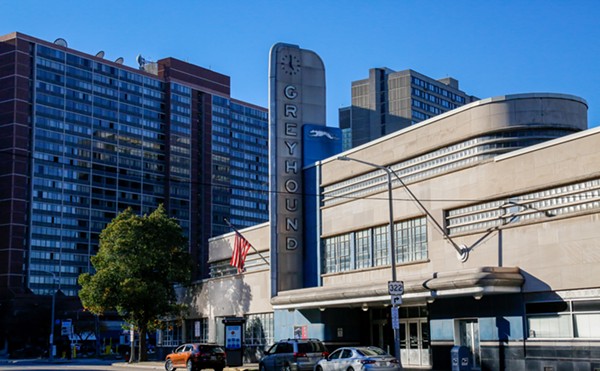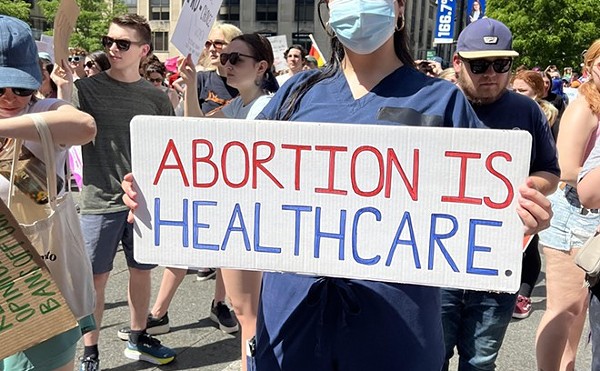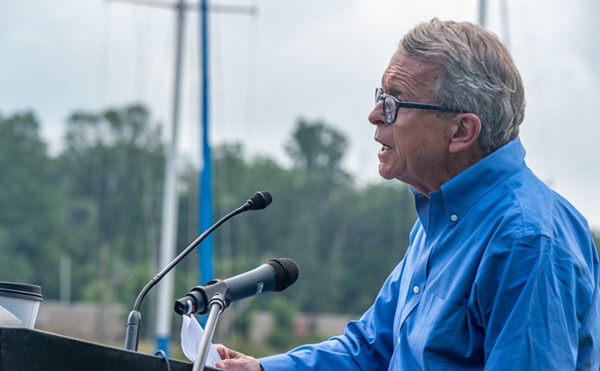The Reverend Ralph Hudak of Immaculate Heart of Mary Church knows his way around a funeral mass. Recently, the Slavic Village priest officiated at five services in eight days. "That was unusual, but we average 60 to 80 a year," Hudak says.
In the same week that Immaculate Heart buried so many dead, the parish announced the closing of one of its schools. Poor finances were blamed, but the K-8 school also drew from a dwindling student base. While one or two funerals a week is standard, Hudak says he performs only six baptisms a year.
Catholic church attendance is a field of study unto itself, but Mayor Jane Campbell can learn from Hudak's weekly planner. In her State of the City address, the mayor said Cleveland should aim to claim at least 500,000 residents by 2010. It's a lofty target. After peaking at 912,000 in the 1950s, the city's population has fallen nearly by half. The 2000 census counted 478,403 residents, down from 505,616 in 1990.
The high side of 500K is more than symbolic. Upon crossing the threshold, the city would be eligible for increased federal aid.
Though she acknowledged the difficulty of reversing downward trends, the mayor may not comprehend the enormity of the task. Her address stated that the city lost 5 percent of its population during the 1990s. Technically, this is correct. But if one removes birth and death rates from the equation, as academics did at Case Western Reserve, the city's population fell by almost 13 percent.
Dr. William J. Sabol and researcher Kristen Mikelbank, who work in the school's Center on Urban Poverty and Social Change, crunched census data and found that 66,712 people left Cleveland during the '90s. Their departures were offset by just 2,426 arrivals. For every person who moved into the city, in other words, more than 27 left.
Quiet Crisis types may now assume positions at the wailing wall.
Sabol says that, if trends hold, the city's population could drop to as low as 440,000 by 2010.
Despite the damning indicators, Cleveland shouldn't be daunted by the task, says Lewis Adkins Jr., an attorney leading the 500K charge. "The fact that the mayor has raised the bar so high is to her credit," he says. A partner in the law firm Roetzel & Andress, Adkins is on loan to the city, his salary paid by a grant from the Cleveland Foundation. The city should feel lucky to have him. "I could sneeze and make $60,000," he says.
Adkins will need all his swagger; he confronts a pandemic. According to the Case study, 27 of 36 neighborhoods lost residents during the '90s. Downtown and University Circle saw the largest gains, but much of their growth can be attributed to an increase in group quarters: college dorms, military barracks, nursing homes, and -- as in the case of downtown -- correctional facilities. "A third of the downtown's population is in jails," Sabol says.
Demographics are shifting as well. Blacks now compose the majority of the city's population and are moving into once predominantly white neighborhoods. The number of African Americans living in Collinwood, for example, increased by 82 percent between 1990 and 2000. Blacks also migrated into several West Side neighborhoods. "Will these neighborhoods stabilize, or will the remaining whites continue to flee?" Sabol wonders.
The problem, Sabol adds, is class flight as much as it is white flight. Blacks are leaving the city, too. Despite a higher than average birth rate, Kinsman lost 23 percent of its population during the '90s. Hough drained by 17 percent. The numbers suggest that African Americans are striving for the outermost neighborhoods and the inner-ring suburbs. The interior of the city is left a husk. "We have a lot of vacant lots," Fairfax Councilwoman Pat Britt says.
What kills Cleveland is that it's so easy to leave. At the moment, hand-wringers are fixated on "brain drain," the idea that the educated young are galloping off to more cosmopolitan cities. This may be true for Northeast Ohio on the whole, but the city proper dies a little death with each acre of sprawl.
During the '90s, Lake, Lorain, Geauga, Medina, and Summit counties grew by 92,000 residents, largely by feasting on Cuyahoga County suburbs. "The movement of people from Euclid to Mentor is staggering," says Dr. Thomas Bier, the director of the Center for Housing Research at Cleveland State. "Who is going to take that housing? It's not going to stand vacant."
Suburban flight to the outer boroughs beckons Clevelanders to take their place in the inner ring, where homes are not much more expensive than in the city. The bundle of goods that comes with suburban living -- i.e., school systems with graduation rates higher than 38 percent -- is appealing to many, Sabol says. "They may have to pay a little more for housing, but that's a trade they're willing to make."
To stem the outward tide, the mayor announced an effort to make Cleveland "strong, smart, and safe." More jobs, better schools, and less crime -- these are hardly unique pursuits for a mayor. But as for specifics, the city appears to be resting its faith on fresh housing stock. Campbell set a goal of 1,500 new units a year. "We did it last year, and we're on pace to do it again this year," Adkins says.
New housing can make a difference. Sabol credits tax-abated construction for gains in parts of Hough and Central. "They are on the right road," Bier says. "The key is to create new housing for people who aren't poor and want to live downtown and in the neighborhoods."
This is not a magic bullet, however. Sabol guesses that someone in the administration did the math and figured that with 1,500 additional housing units a year, Cleveland would roof enough new residents to join the half-million club by 2010. The trouble with this scenario? It doesn't factor in continued flight. "Nobody considered the out-migration of the population," Sabol says.
While overly optimistic, the city is at least trying to do something. "The other choice is to ignore it and pretend it doesn't exist," says Adkins.
One idea for Cleveland to consider: Emphasize the stimulation of urban living and relinquish the hope of competing on scholastics. The city, obviously, can't abandon its schools, but as Councilman Roosevelt Coats says: "You can make the floor gold, and they still won't come back in."














